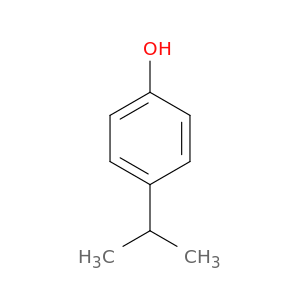
4-Isopropylphenol
| Title | Journal |
|---|---|
| Predicting anti-androgenic activity of bisphenols using molecular docking and quantitative structure-activity relationships. | Chemosphere 20161101 |
| Screening of Toxic Effects of Bisphenol A and Products of Its Degradation: Zebrafish (Danio rerio) Embryo Test and Molecular Docking. | Zebrafish 20161001 |
| Bioactivation of bisphenol A and its analogs (BPF, BPAF, BPZ and DMBPA) in human liver microsomes. | Toxicology in vitro : an international journal published in association with BIBRA 20130601 |
| A case of propofol-induced oropharyngeal angioedema and bronchospasm. | Allergy, asthma & immunology research 20120101 |
| Removal of BPA model compounds and related substances by means of column chromatography using Octolig®. | Journal of environmental science and health. Part A, Toxic/hazardous substances & environmental engineering 20120101 |
| The mouse eugenol odorant receptor: structural and functional plasticity of a broadly tuned odorant binding pocket. | Biochemistry 20110208 |
| Oxidative removal of bisphenol A using zero valent aluminum-acid system. | Water research 20110201 |
| Evaluation of Maternal Toxicity in Rats Exposed to Multi-Wall Carbon Nanotubes during Pregnancy. | Environmental health and toxicology 20110101 |
| Synthesis and SAR studies of 1,4-benzoxazine MenB inhibitors: novel antibacterial agents against Mycobacterium tuberculosis. | Bioorganic & medicinal chemistry letters 20101101 |
| Modeling of ultrasonic degradation of non-volatile organic compounds by Langmuir-type kinetics. | Ultrasonics sonochemistry 20100601 |
| Isolation and characterization of a novel 2-sec-butylphenol-degrading bacterium Pseudomonas sp. strain MS-1. | Biodegradation 20100401 |
| The aqueous degradation of bisphenol A and steroid estrogens by ferrate. | Water research 20080101 |
| Direct evidence revealing structural elements essential for the high binding ability of bisphenol A to human estrogen-related receptor-gamma. | Environmental health perspectives 20080101 |
| ipso-substitution: a general biochemical and biodegradation mechanism to cleave alpha-quaternary alkylphenols and bisphenol A. | Chemistry & biodiversity 20070901 |
| Anaerobic biodegradation of 4-alkylphenols in a paddy soil microcosm supplemented with nitrate. | Chemosphere 20070801 |
| Anaerobic co-metabolic oxidation of 4-alkylphenols with medium-length or long alkyl chains by Thauera sp., strain R5. | Applied microbiology and biotechnology 20070701 |
| Aerobic and anaerobic biodegradation of phenol derivatives in various paddy soils. | The Science of the total environment 20060831 |
| A novel sulfotransferase abundantly expressed in the dauer larvae of Caenorhabditis elegans. | Journal of biochemistry 20060301 |
| Dose-dependent influence of barbiturates but not of propofol on human leukocyte phagocytosis of viable Staphylococcus aureus. | Critical care medicine 20060201 |
| Effect of metal chlorides on thermal degradation of (waste) polycarbonate. | Waste management (New York, N.Y.) 20060101 |
| Cooperative h-bonds of macromolecules. 1. Binding of low-molecular-weight ligands to polymers. | The journal of physical chemistry. B 20050721 |
| Biodegradation of phenolic environmental pollutants by a surfactant-laccase complex in organic media. | Journal of bioscience and bioengineering 20050601 |
| Genotoxicity evaluation of electromagnetic fields generated by 835-MHz mobile phone frequency band. | European journal of cancer prevention : the official journal of the European Cancer Prevention Organisation (ECP) 20050401 |
| Bioregeneration of powdered activated carbon in the treatment of alkyl-substituted phenolic compounds in simultaneous adsorption and biodegradation processes. | Chemosphere 20050101 |
| Photodegradation of bisphenol-A with TiO2 immobilized on the glass tubes including the UV light lamps. | Water research 20040901 |
| Characterization of new bisphenol a metabolites produced by CD1 mice liver microsomes and S9 fractions. | Journal of agricultural and food chemistry 20040728 |
| Aquatic toxicity of four alkylphenols (3-tert-butylphenol, 2-isopropylphenol, 3-isopropylphenol, and 4-isopropylphenol) and their binary mixtures to microbes, invertebrates, and fish. | Environmental toxicology 20040201 |
| Photochemical transformations of tetrabromobisphenol A and related phenols in water. | Chemosphere 20040101 |
| Photodegradation mechanism for bisphenol A at the TiO2/H2O interfaces. | Chemosphere 20030801 |
| Treatment of phenolic wastewater using agricultural wastes as an adsorbent in a sequencing batch reactor. | Water science and technology : a journal of the International Association on Water Pollution Research 20030101 |
| Variable-temperature studies of the 4-isopropylphenol crystal structure from X-ray diffraction. Comparison of thermal expansion and molecular dynamics with spectroscopic results. | Acta crystallographica. Section B, Structural science 20020801 |
| A lipoxygenase inhibitor from Aspergillus niger. | Applied microbiology and biotechnology 20020301 |
| Characterization of rabbit UDP-glucuronosyltransferase UGT1A7: tertiary amine glucuronidation is catalyzed by UGT1A7 and UGT1A4. | Archives of biochemistry and biophysics 19970815 |